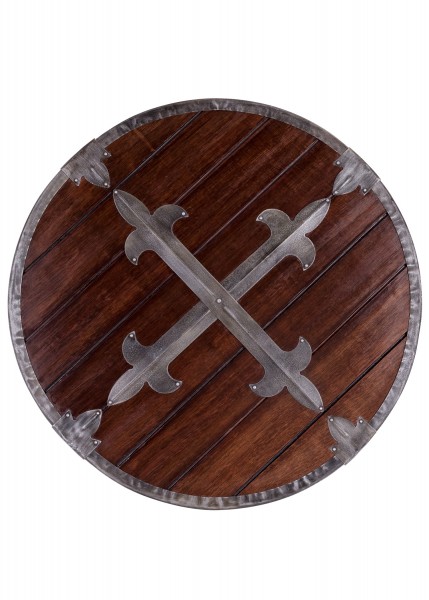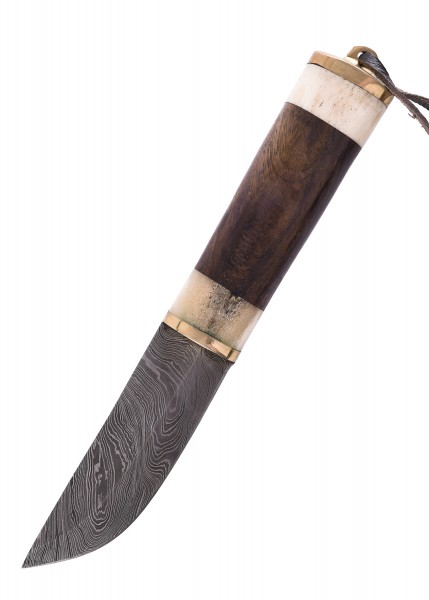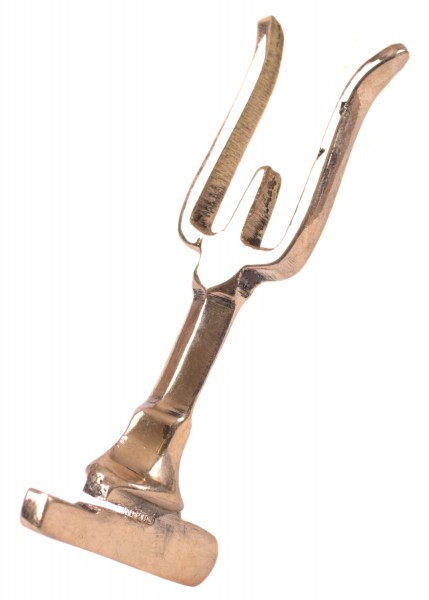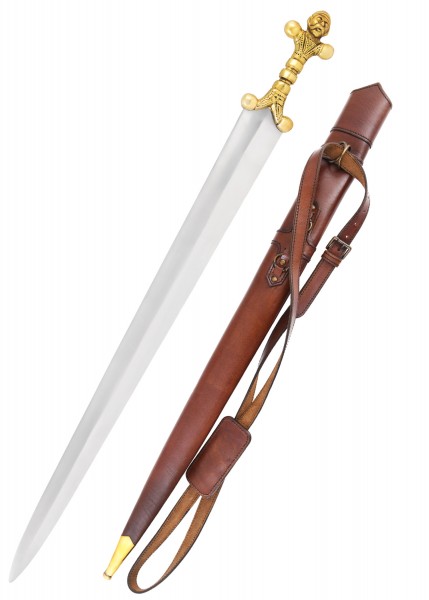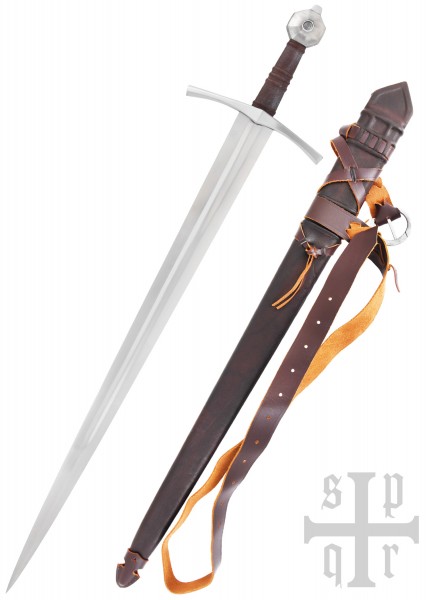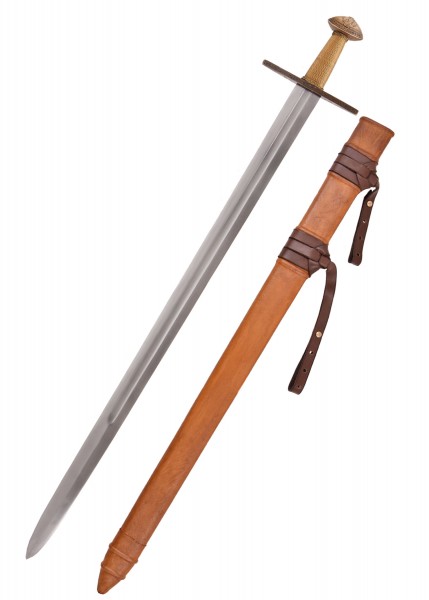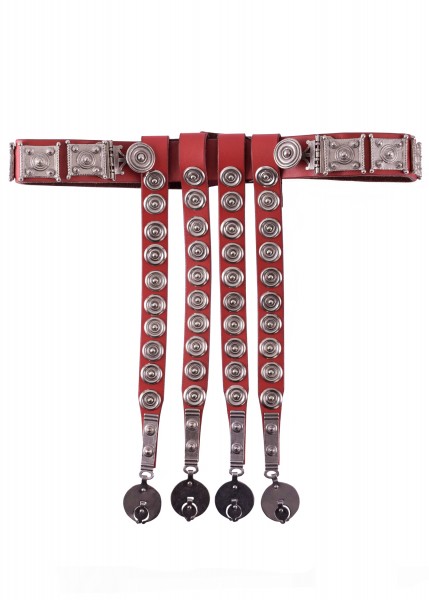€139.99 *
Prices incl. VAT plus shipping costs
Ready to ship, Delivery time approx. 1-3 working days
Spatha, Late Roman Sword with Scabbard, 2nd / 3rd Century AD This spatha is not a one-to one...more
Product information "Spatha, Late Roman Sword with Scabbard"
Spatha, Late Roman Sword with Scabbard, 2nd / 3rd Century AD
This spatha is not a one-to one replica of an actual historical piece, but a reconstruction based on several original finds from the 2nd and 3rd centuries.
As from the late 2nd c. AD, the long Roman spatha gradually started to supersede the shorter gladius. By the 3rd c., it had already become the standard weapon of the imperial Roman legionaries and auxiliaries and was also commonly used by gladiators. The exact origins of the spatha as well as the reasons why it replaced the efficient, highly feared gladius so quickly during the mid to late Roman Empire are still very much debated among historians, archaeologists and Ancient Rome enthusiasts alike until today. Although spathae are commonly believed to be of Celtic descent and to have owed their fast popularity to changes in fighting techniques and military tactics in both the Roman infantry and cavalry, the lack of reliable sources on the subject unfortunately often leads to speculations and over-simplifications of a much more complex reality.
The Roman long sword we offer here features a broad, double-edged EN45 spring steel blade with dual fullers on each side and a 5 cm long ricasso. The edges are not sharpened and the blade's full tang is screwed to the pommel (brass top nut). The hilt with generously sized pommel is made of wood and accented with brass details. The grip part is nicely carved and the guard equipped with a protective brass plate.
This Roman one-handed sword comes complete with a red wood-and-leather scabbard with brass fittings – a throat band, a circular chape, a protective frame or side gutters and a decorative central ridge with integrated suspension loop to hang the sword from your belt or baldric (max. belt width approx. 4.5 cm). The most distinctive feature of this sheath is obviously the oversized round plate (also known as disc chape or pillbox chape) which is ornately engraved with a rosette motif.
Please note that this Roman sword is not a battle ready weapon. It is designed as a collector's or decoration/display piece and is not suited for combat reenactment. Besides its quality as a collectible, it is also perfectly suited as a prop, e.g. to complete your costume.
Details:
- Material: EN45 spring steel blade (high carbon steel, not stainless), wooden hilt with brass accents
- Overall length: approx. 99 cm
- Blade length: approx. 78 cm
- Blade thickness: approx. 4 mm / 3.6 mm (cutting edges approx. 1 mm)
- Hilt length: approx. 21 cm (grip approx. 9.5 cm)
- Max. blade width: approx. 6 cm
- Point of balance: approx. 25 cm from the guard
- Incl. wooden scabbard with genuine leather cover and brass fittings
- Scabbard width at mouth: approx. 8 cm
- Scabbard width before the chape: approx. 7 cm
- Diameter of the scabbard’s disc chape: approx. 8 cm
- Weight without scabbard: approx. 1.4 kg
- Weight with scabbard: approx. 2.16 kg
Specs may slightly vary from piece to piece.
The steel used here is not rust-proof and might show slight surface tarnishing in places. We recommend you to maintain the blade on a regular basis, for example using Ballistol Universal Oil, which is ideally suited for steel care.
Please note:
We do not sell this product to customers under the age of 18. Please provide your birth date when ordering. We'll also need a copy of your ID-card or passport by email, scan, fax or mail.
This spatha is not a one-to one replica of an actual historical piece, but a reconstruction based on several original finds from the 2nd and 3rd centuries.
As from the late 2nd c. AD, the long Roman spatha gradually started to supersede the shorter gladius. By the 3rd c., it had already become the standard weapon of the imperial Roman legionaries and auxiliaries and was also commonly used by gladiators. The exact origins of the spatha as well as the reasons why it replaced the efficient, highly feared gladius so quickly during the mid to late Roman Empire are still very much debated among historians, archaeologists and Ancient Rome enthusiasts alike until today. Although spathae are commonly believed to be of Celtic descent and to have owed their fast popularity to changes in fighting techniques and military tactics in both the Roman infantry and cavalry, the lack of reliable sources on the subject unfortunately often leads to speculations and over-simplifications of a much more complex reality.
The Roman long sword we offer here features a broad, double-edged EN45 spring steel blade with dual fullers on each side and a 5 cm long ricasso. The edges are not sharpened and the blade's full tang is screwed to the pommel (brass top nut). The hilt with generously sized pommel is made of wood and accented with brass details. The grip part is nicely carved and the guard equipped with a protective brass plate.
This Roman one-handed sword comes complete with a red wood-and-leather scabbard with brass fittings – a throat band, a circular chape, a protective frame or side gutters and a decorative central ridge with integrated suspension loop to hang the sword from your belt or baldric (max. belt width approx. 4.5 cm). The most distinctive feature of this sheath is obviously the oversized round plate (also known as disc chape or pillbox chape) which is ornately engraved with a rosette motif.
Please note that this Roman sword is not a battle ready weapon. It is designed as a collector's or decoration/display piece and is not suited for combat reenactment. Besides its quality as a collectible, it is also perfectly suited as a prop, e.g. to complete your costume.
Details:
- Material: EN45 spring steel blade (high carbon steel, not stainless), wooden hilt with brass accents
- Overall length: approx. 99 cm
- Blade length: approx. 78 cm
- Blade thickness: approx. 4 mm / 3.6 mm (cutting edges approx. 1 mm)
- Hilt length: approx. 21 cm (grip approx. 9.5 cm)
- Max. blade width: approx. 6 cm
- Point of balance: approx. 25 cm from the guard
- Incl. wooden scabbard with genuine leather cover and brass fittings
- Scabbard width at mouth: approx. 8 cm
- Scabbard width before the chape: approx. 7 cm
- Diameter of the scabbard’s disc chape: approx. 8 cm
- Weight without scabbard: approx. 1.4 kg
- Weight with scabbard: approx. 2.16 kg
Specs may slightly vary from piece to piece.
The steel used here is not rust-proof and might show slight surface tarnishing in places. We recommend you to maintain the blade on a regular basis, for example using Ballistol Universal Oil, which is ideally suited for steel care.
Please note:
We do not sell this product to customers under the age of 18. Please provide your birth date when ordering. We'll also need a copy of your ID-card or passport by email, scan, fax or mail.
Links related to "Spatha, Late Roman Sword with Scabbard"
Cookie settings
This website uses cookies which are necessary for the technical operation of the website and are always set. Other cookies, which increase the comfort when using this website, are used for direct advertising or to facilitate interaction with other websites and social networks, are only set with your consent.
Last viewed




















